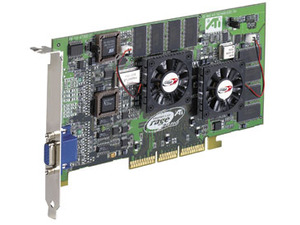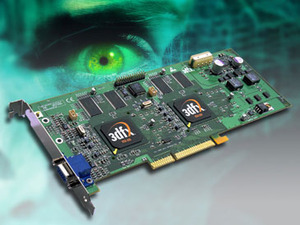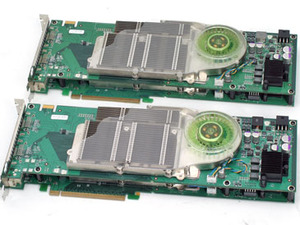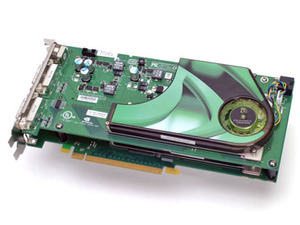Two GPUs on a card
Now that we’ve been over the Radeon HD 3870 X2, it’s worth pointing out that dual GPU graphics cards have been released on several occasions in the past, so this isn’t anything particularly new in that respect. In fact, the first dual-GPU graphics card to be announced was the Quantum3D Obsidian2 card, which was based on a pair of Voodoo 2s and was announced on 31st March 1998 – that’s almost ten years ago!Then there was ATI’s Rage Fury MAXX in late 1999 and how could we forget the Voodoo5 5500? Things died down a bit after that (and so did 3dfx, mind you), but then with the introduction of SLI (and then later CrossFire), there was an influx of dual-GPU cards from ATI and Nvidia add-in board partners. Then in 2006, Nvidia introduced the OEM-only GeForce 7900 GX2 with its first attempt at Quad-SLI, which was then closely followed by the shorter and more refined retail version: the GeForce 7950 GX2.
Now, the GeForce 7950 GX2 was a pretty good card when it first launched—and we liked it—but then Nvidia’s lack of support for both GPUs on the card under Windows Vista really left a sour taste in our mouths. In fact, it wasn’t until March that the GeForce 7950 GX2 received ‘beta’ support in Vista for both GPUs – a little ironic considering most board partners’ boxes featured the Nvidia Vista Essentials logo, which would normally suggest Vista support out of the box.


ATI's Rage Fury MAXX (left) & 3dfx's Voodoo5 5500 (right)
You see the trend we’re seeing here is that dual-GPU graphics cards haven’t become a trend for a reason – they don’t tend to work as transparently as a traditional single-GPU card works. There’s only really one reason for this and that is of course the drivers. Without transparency, a multi-GPU solution is never going to be as good as a single GPU solution because there are inevitably going to be times when the drivers lag behind the games.
The problem is that today’s multi-GPU solutions—from both ATI and Nvidia—rely on the driver team being ahead of the game release calendar, delivering performance-optimised drivers the day that games launch. They also rely on the game developers enabling support for the technology from both GPU manufacturers as well.
I talked about this a little (well, OK, it was a lot) in our Radeon HD 3870 architectural review and I talked again with AMD about dual-GPU graphics cards at the Radeon HD 3870 X2 briefing. My stance hasn’t changed much since the first time I talked about it and this hardware launch makes my point even more important – the game developers, with the help of ATI’s driver and developer relations teams, need to be implementing CrossFire support out of the gate (or at least within a week of its launch) in as many of the big titles as possible.


Nvidia's GeForce 7900 GX2 (left) & GeForce 7950 GX2 (right)
Of course, the titles we’ve used for our testing in this article are a cross section of some of last year’s biggest titles, but what it doesn’t show is performance in some of the more obscure titles on the market. And, as a matter of fact, I can’t tell you how this card will perform when this year’s biggest titles are released because it depends entirely on the situation I’ve outlined above.
If the game is supported on the day of launch, you’ll get the performance you’ve paid for, but if it isn’t you’ll get the equivalent of a single Radeon HD 3870 in a best case scenario—and that’s roughly half the price of the HD 3870 X2. It’s a problem and it makes it very hard to predict how this card might perform later in its life in titles that haven’t been released yet.

MSI MPG Velox 100R Chassis Review
October 14 2021 | 15:04









Want to comment? Please log in.